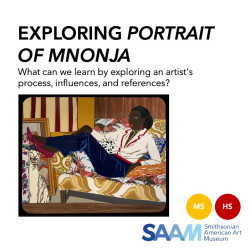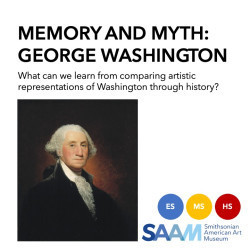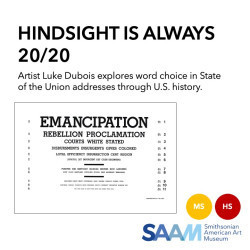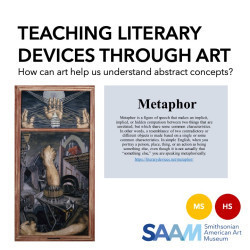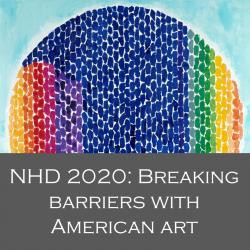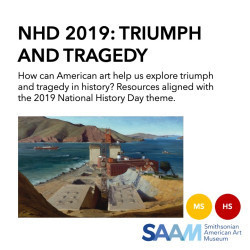Phoebe Hillemann
Teacher Institutes Educator
Smithsonian American Art Museum
As the Teacher Institutes Educator at the Smithsonian American Art Museum, I organize our week-long summer institutes for middle and high school English and social studies teachers: http://americanart.si.edu/institutes. I'm interested in interdisciplinary thinking, arts integration, and the power of dialogue in learning spaces.
Phoebe Hillemann's collections
Exploring Mickalene Thomas's Portrait of Mnonja
<p>In this activity, students will explore Mickalene Thomas's process, artistic influences, and art historical context. Students will examine Thomas's <em>Portrait of Mnonja </em>(2010, Smithsonian American Art Museum) in depth, and use three supporting resources to build context.</p>
<p>1. Have students look at Mickalene Thomas's <em>Portrait of Mnonja</em>. Give them 2-3 minutes to do a quick sketch of the painting.</p>
<p>2. Next, ask them to note the part of the painting their eye went to first on their sketch with a star.</p>
<p>3. Next, ask students to draw a line through their sketch to show the path their eye used to travel through the painting. Use arrows to indicate direction.</p>
<p>4. In pairs or as a class, ask students to share where their eye went first, and why they think it went there. Was it the color? Light? Lines? The placement in the composition?</p>
<p>5. Next, students should write a list of 8-10 words and phrases describing the painting. Ask for volunteers to share out.</p>
<p>6. As a group, discuss students' impressions of the painting. Ask for visual evidence to back up claims. (e.g. A student says, "she looks powerful." You ask, "what do you see that makes you say she's powerful?")</p>
<p>7. To further the conversation, share some background information about the painting: the title, the date, and the artist. Explain a little about Mickalene Thomas's process: posing live models in sets with props and furniture, taking photographs, then painting from the photographs.</p>
<p>8. Next, break students into small groups. Each group should receive a printout of ONE of the three supporting resources in this collection. Ask them to compare and contrast their image with <em>Portrait of Mnonja</em>.</p>
<p>9. After 4-5 minutes, ask each group to share out the main idea from what they discussed. The teacher should add additional information as it is useful.</p>
<p>a. Mickalene Thomas set photograph: Shows the artist's process, how she uses real models and sets. Note patterns and 1970s motifs.</p>
<p>b. Romare Bearden collage: Thomas has cited Bearden as one of her artistic influences. Students should note similarities in color, pattern, and flatness.</p>
<p>c. John Collier painting: An example from the early 1900s of the "reclining woman" in art history. Students should discuss the passiveness/agency of each of these women, and how a male artist's depiction of a woman differs from a female artist's in this case. Thomas was well versed in art history and was consciously making reference to precedents like this.</p>
<p>10. Writing Activity: In small groups, have students write a dialogue between Mnonja and someone else. It could be the artist, the viewer, or someone from one of the supporting resources.</p>
<p><em><br></em></p>
<p><em>Optional:</em> Have students view one or both of the short videos of Mickalene Thomas discussing<em> Portrait of Mnonja</em>. </p>
<p>#BecauseOfHerStory<br></p>
 Phoebe Hillemann
Phoebe Hillemann
7
Memory and Myth: George Washington in American Art
<p>George Washington is one of the most mythologized icons of American history, and one of the most frequently represented figures in American art. What can comparing and contrasting these varying representations tell us about our national understanding of this founding father and first American President? How does the historical context during which an artwork was made affect its subject matter? How does American art influence the way we think of Washington today? </p><p>Created for the National Council for History Education (NCHE) 2018 annual conference.</p>
 Phoebe Hillemann
Phoebe Hillemann
19
Hindsight is Always 20/20
<p>In <em>Hindsight is Always 20/20</em>, Luke DuBois took the State of the Union addresses from each presidency (up through George W. Bush) and sorted them according to word frequency. The artist then printed the most frequently appearing works as an eye chart for each president, with the more frequently used words in larger type at the top of the chart and the less frequently used words toward the bottom. The traditional eye chart includes sixty-six letters; Luke DuBois’s charts substitute sixty-six words. The lists contain words that are not only important for the issues addressed by each president but also give an impression of how language was used at the time. Each of the forty-one presidencies to have State of the Union addresses at the time DuBois created this series (William Henry Harrison and James Garfield died before they could submit a single message to Congress) has its own eye chart. </p>
<p><em>Multiplicity</em>, 2011</p>
 Phoebe Hillemann
Phoebe Hillemann
42
NHD 2019: Triumph and Tragedy in American Art
<p>This collection is designed to support teachers and students exploring the 2019 National History Day theme: Triumph and Tragedy in History. Included in this collection are four prospective topics aligned with the NHD theme, for each of which we have supplied American artworks that could be used as primary source texts and/or inspiration for further research.</p>
<p>Was George Catlin's Indian Gallery an artistic triumph or exploitation of tragedy? How did the expansion of the railroad in the U.S. lead to both triumph and tragedy? How did the Public Works of Art Project (PWAP) -- the first New Deal program supporting American artists -- create triumph out of the tragedy of the Great Depression? And finally, how was the fight for African American civil rights shaped by triumph and tragedy?</p>
<p>#NHD2019 #NHD</p>
 Phoebe Hillemann
Phoebe Hillemann
41
Do Ho Suh: Almost Home
<p>Do Ho Suh’s immersive architectural installations—unexpectedly crafted with ethereal fabric—are spaces that are at once deeply familiar and profoundly alien. Suh is internationally renowned for his “fabric architecture” sculptures that explore the global nature of contemporary identity as well as memory, migration, and our ideas of home.</p>
<p>Suh was born in Korea and moved to the United States at the age of 29 in 1991, and he currently lives between New York, London, and Seoul. He crafts his works using traditional Korean sewing techniques combined with 3-D modeling and mapping technologies. Suh sees these works as “suitcase homes,” so lightweight and portable they can be installed almost anywhere.<br /></p>
<p>Essential Questions:</p>
<ul><li>What is home?
</li><li>How does perspective-taking help us better understand people, events, or issues?</li><li>How can artwork be used as a provocation for the exercise of higher order thinking and transdisciplinary application of content?</li></ul><p>Created for a program with the National Teachers of the Year on April 30, 2018.</p>
<p>#NTOY18</p><p><em>#visiblethinking</em><br /></p>
 Phoebe Hillemann
Phoebe Hillemann
13

